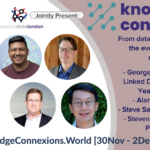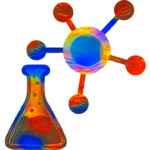Return of the Graph: Geospatial Knowledge Graphs, Personal Knowledge Graphs, and Evolution. The Year of the Graph Newsletter Vol. 24, Spring 2023

New types of graphs, and a new era for the Year of the Graph Newsletter
The Year of the Graph Newsletter, keeping track of all things Graph year over year, is back after a long hiatus.
Read on to learn more about how the evolution of the newsletter follows the evolution of the domain and how to be involved, as well as industry news and analysis hot off the press:
- The evolution of Graph and the Year of the Graph Newsletter
- Knowledge Graphs are in conversational mode
- Graph Database growth going strong through the Trough of Disillusionment
- Graph AI is hot in research and making inroads into industry
- Graph Analytics go big and realtime
- Foursquare Graph, the first Geospatial Knowledge Graph
- The Personal Knowledge Graph book, the first book on PKGs
The evolution of Graph and the Year of the Graph Newsletter
A lot of water has flowed under the bridge since the last issue of the YotG Newsletter. Two years is a long time in technology, especially for something as diverse and rapidly evolving as graphs. Here is a letter from the editor with a recap of what happened during the hiatus, and what’s coming next.
In terms of evolution of the Graph landscape, a few things have changed. The Newsletter may have taken a break, but keeping track of all things Graph Year over Year never stopped. The following sections assess where Knowledge Graphs, Graph Databases, Graph Analytics and Graph AI are today and where they’re headed to.
As you may know if you have been following the YotG Newsletter for a while, the editor here would be myself – George Anadiotis. I’ve been into graph in one way or another since the early 2000s. I’ve built Graph Database prototypes, was a part of award-winning Graph R&D, and led teams using Graph Databases in production.
In the last few years, i’ve been active as an analyst and writer covering Graph technology. I participated in the pivotal W3C Web Standardization for Graph Data initiative in Berlin as an independent expert and i have authored 3 reports and numerous articles on Graph Databases and beyond. I have also been organizing Connected Data World and compiling the YotG newsletter. And that’s not even all i do.
That’s a lot, so something’s got to give. This is what induced the hiatus, and why the YotG Newsletter is changing. The newsletter has historically been a long list featuring short excerpts from all-around industry news on all things Graph Analytics, Graph Databases, Knowledge Graphs, Graph AI and Data Science, compiled by myself exclusively. That was not sustainable.
Going forward, the newsletter will be shorter, featuring longer excerpts from my own work on Graph, as well as a brief editorial and some analysis. Updates from industry and research are still published on the YotG Twitter and LinkedIn accounts. Feel free to follow those for the latest news, and reach out if you are interested in contributing.
The YotG web site has been revamped. It looks better and is easier to navigate, but the biggest change is that YotG’s list of resources on all things Graph Analytics, Graph Databases, Knowledge Graphs, and Graph AI are now available under the corresponding sections. Feel free to browse, search, learn, and share.
Fun fact #1: Classifying the huge backlog of 3K+ resources was done with a little help from ChatGPT.
Last but not least, you can always contact the YotG if you want to:
- Ask a question or share an invite
- Submit news items or otherwise contribute
- Inquire about sponsored content or professional services
Knowledge Graphs are in conversational mode
The emergence of ChatGPT and the subsequent hype have made people across different domains think about ways they could use Large Language Model (LLM) technology to their benefit. Knowledge Graphs are no exception. As Dean Allemang puts it:
“Quite a lot [of what I’ve been reading about ChatGPT and LLMs] has to do with how the weaknesses of LLMs can be addressed by the use of [people’s] favorite technology. This is probably because I hang out in groups where people are interested in their own pet technology.
Since I have been an advocate for Knowledge Graph technology for many years, I am as guilty of this as the next writer, of thinking that the key to making LLMs useful is to combine them with Knowledge Graphs”.
There has been no shortage of ideas on how to combine Knowledge Graphs with LLMs. Most of them fall under one of three categories: using an LLM to create a new Knowledge Graph, using an LLM to access an existing Knowledge Graph, or using a Knowledge Graph to augment a LLM. There are numerous ongoing efforts and experiments, of which we are going to share just a few.
GraphGPT creates a knowledge graph of the connections between people and proper nouns contained in input sentences. GraphGPT uses GPT-3 and was created by Varun Shenoy , a researcher at Stanford University.
Peter Lawrence shows how a knowledge graph can prompt or fine-tune a LLM enabling users to ask their questions. To illustrate this, he uses an RDF knowledge graph of a process plant, the core of a Digital-Twin, to prompt or fine-tune OpenAI’s GPT LLM. Fun fact #2: we called this back in 2020.
Tony Seale, Knowledge Graph Engineer at UBS, suggests harnessing the power of Knowledge Graphs for Language Model governance. This includes alignment with an ontological worldview, i.e. leveraging concepts defined in a Knowledge Graph’s ontology to constrain the language model.
Graph Database growth going strong through the Trough of Disillusionment
One of the first items in the YotG graph collection of graph resources was a Graph Database market forecast report by Markets and Markets. Back in early 2018, the report valued the Graph Database market size at $700 Million in 2017 and projected it to reach $2,4 Billion by 2023, at a Compound Annual Growth Rate (CAGR) of 24%.
That’s pretty substantial and pretty optimistic, but has it actually materialized?
In the most recent update of this report by Markets and Markets in 2022, the Graph Database market size is estimated at $1,9 Billion in 2021 and projected it to reach $5,1 Billion by 2026, at a CAGR of 22,5%.
Even though it’s not really possible to verify those estimates except against previous estimates, in that respect the projections seem pretty much on the mark. CAGR has declined somewhat but remains high and the market is still poised for growth. But it has not been uninterrupted growth all the way. If we take Gartner’s hype cycle at face value, Graph Databases are probably still going through the Trough of Disillusionment.
That means that the utility of graph databases may be questioned. In addition, recent and ongoing economic downturn has not left the graph database market unaffected. Some vendors were part of the wave of layoffs, others have changed leadership, funding has slowed down and the economic climate is reportedly having an impact on sales.
But that does not mean progress is stalling either. Investing in Graph Databases has not evaporated – far from it. And Graph Databases keep working on becoming more accessible, adding cloud services, visual interfaces and – you guessed it – conversational interfaces too.
RDF and LPG Graph Databases are converging through RDF-star, the RDF update that enables RDF to operate as property graphs, and GQL, the new international standard query language that is expected to be generally available in 2024.
If you are looking to decipher Graph Databases and make a decision on what is the right solution for you, check out the YotG Graph Database report for detailed vendor by vendor analysis.
Graph AI is hot in research and making inroads into industry
When the YotG first included Graph AI in its coverage, Graph AI was considered exotic. While Graph AI is still generating lots of research output, it’s also making inroads into industry.
Even back in 2019, Graph AI was a considerable part of new research in top AI venues. That trend has been accelerating; for example, check out this Guide to ICLR 2023, where Graph Representation Learning, Geometric Deep Learning and its applications for molecular modeling and physics are key themes.
Transformers, the architecture behind LLMs, can also be viewed as a Graph Neural Network. Graph Convolutional Networks (GCNs) combine deep learning with feature diffusion to produce useful node embeddings. And Geometric Deep Learning provides a common blueprint allowing to derive from first principles neural network architectures as diverse as CNNs, GNNs, and Transformers.
Somewhere in between research and industry is the concept of Neural Graph Databases. Tailored for large incomplete graphs and on-the-fly inference of missing edges using graph representation learning, neural reasoning promises to maintain high expressiveness and support complex logical queries similar to standard graph query languages.
In its short history, Graph AI has had a strong footing in the pharma industry with applications in drug discovery. Recursion, a major player in drug discovery, has just acquired two startups in order to leverage their Graph AI-powered intellectual property: Valence Discovery (Mila, Montreal) for $47.5M and Cyclica (Toronto) for $40M. Beyond pharma, Graph AI is also used at the likes of Airbnb.
Graph Analytics go big and realtime
Graph Analytics is coming on its own. There are a few noteworthy pieces of evidence to back up this claim. First, there are now multiple market forecast reports that consider Graph Analytics a market of its own. For example, Research and Markets states that:
“The global graph analytics market in 2022 was valued at US$1.14 billion. The market value is anticipated to grow to US$6.90 billion by 2028. The market value is expected to grow at a CAGR of 34.80% during the forecast period of 2023-2028”.
Second, there are more and more resources around graph analytics, and they generate a lot of interest. Some recent examples: Maryam Miradi’s collection of 25 top Python libraries, types, algorithms and techniques for Graph Analytics. Amy Hodler’s Graph Analytics talk for G-Research in London.
More than anything else, however, it’s the fact that Graph Analytics are having an impact in the real world. From ESG to Customer 360, finance, supply chains, retail and anti-fraud, Graph Analytics is gaining adoption and becoming a significant part of vendor revenue. The importance of Graph Analytics may make it a central part of Databricks’ strategic decisions going forward too.
In industry use cases, the requirements often dictate processing large volumes of data in near-realtime. Graph analytics are growing in that direction, as exemplified by the likes of PayPal and LinkedIn. There are now solutions for streaming Graph Analytics, too. Plus, Graph Analytics are powering cybersecurity unicorns. We’re watching this space and we’ll be back with more details.
Foursquare moves to the future with a Geospatial Knowledge Graph
If the name Foursquare rings a bell, it means you were around in the 2010s. Your only resort to plausible deniability would be if you are a data professional – although that’s not an either/or proposition.
In the 2010s, Foursquare was a consumer-oriented mobile application. The premise was simple: people would check in at different locations and get gamified rewards. Their location data would be shared with Foursquare and used for services such as recommendations.
Facebook and Yelp got the lion’s share of that market, but Foursquare is still around. In addition to having 9 billion-plus visits monthly from 500 million unique devices, Foursquare’s data is used to power the likes of Apple, Uber and Coca-Cola.
Recently the company announced Foursquare Graph, what it dubs the industry’s first application of graph technology to geospatial data.
Heroes journey: Notes towards a Personal Knowledge Graphs Book
The last couple of years have seen the emergence of a new type of Knowledge Graphs: Personal Knowledge Graphs. Knowledge Graph definitions abound. Personal Knowledge Graph definitions are in flux.
Previously, Personal Knowledge Graphs were academically defined as graphs containing facts about a person, held by a 3rd party. That has recently changed,. More importantly, however, Personal Knowledge Graphs power a booming ecosystem of real-world tools focused on end-users, with data sovereignty and note-taking as key elements.
Note-taking is a timeless practice. Over time, a multitude of software tools have been developed to assist with note-taking. Applying Graph metaphors and principles in the personal information management domain and note-taking results in what we call Personal Knowledge Graphs.
The first book on Personal Knowledge Graphs is a journey of exploration and mapping of emergent practices and tools.
The hero’s journey is a common template of stories that involve a hero who goes on an adventure, is victorious in a decisive crisis, and comes home transformed. Writing a book is like a journey too. Writing the first Personal Knowledge Graphs book involved more than one hero and a few crises.
Would you like to receive the latest Year of the Graph Newsletter in your inbox? Easy – just signup below. Have some news you think should be featured in an upcoming newsletter? Easy too – reach out here.













2 comments to “Return of the Graph: Geospatial Knowledge Graphs, Personal Knowledge Graphs, and Evolution. The Year of the Graph Newsletter Vol. 24, Spring 2023”
[…] all these integrations fall under one of the three ways people are attempting to use knowledge graphs and LLMs in tandem: using an LLM to create a new Knowledge Graph, using an LLM to access an existing Knowledge Graph, […]
[…] KG-enhanced LLMs, LLM-augmented KGs, and synergized LLMs + KGs. Cf. the previous YotG issue here. Similarly, researchers from The Hong Kong University of Science and Technology (Guangzhou), The […]